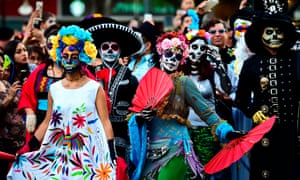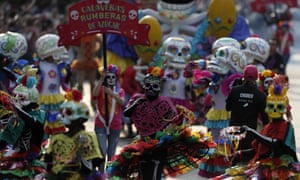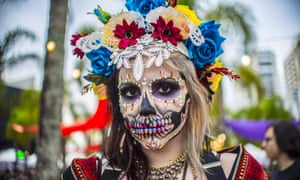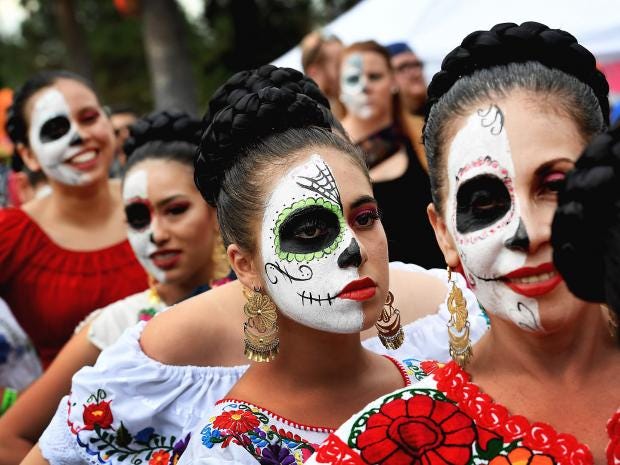Mexicans embrace Day of the Dead spectacle in place of Halloween
Inspired by a James Bond parade scene, festivities including La Catrina are taking over from the once-popular trick or treat
People dressed as ‘Catrina’ for Day of the Dead parade in Mexico City, Mexico. Photograph: ctober 2017 05.00 GMTLast modified on Tuesday 31 October 2017 22.00 GMT
Paul del Castillo strolled down Mexico City’s grand Paseo de la Reforma dressed in a tuxedo and top hat. His wife, Fabiola Martínez, wore a wedding dress. Both had their faces painted as skulls.
Mexico City’s day of the dead parade – in pictures
Castillo, who runs a small shop, said that he used to celebrate Halloween. But this year the couple plunged into the festivities to mark the Day of the Dead, which in Mexico’s main cities is incorporating the fun of Halloween – and trading solemn ceremony and private introspection for partying and public spectacle.
“I like Halloween. But I like our Mexican culture, our Mexican traditions better,” said Del Castillo. “This is reviving a Mexican cultural tradition. And it’s displacing Halloween.”
Until recently, some Mexicans fretted that the imported celebration of Halloween would overshadow the Day of the Dead. But the Mexican festival has proved remarkably resilient.
Mexicans mark the day by building altars in their homes, with offerings of food and drink for the departed and they still hold grave-side vigils on 2 November, when they believe their relatives return to visit.
But in the past five years, Dead of the Day has moved out of the graveyard and into the public street, thanks in part to Hollywood.
The Day of the Dead parade in Mexico City was bigger than last year’s, which was inspired by the James Bond movie Spectre. Photograph: Eduardo Verdugo/AP
The festival features prominently in the new Pixar movie Coco – which provoked a flash of outrage during its development when Disney made an abortive attempt to trademark the phrase “Day of the Dead”.
Mexico City held its first Day of the Dead parade last year, inspired by an episode in the James Bond movie Spectre but embraced by thousands of ordinary participants.
Mexico City's James Bond-inspired Day of the Dead parade gets mixed reviews
This year’s event was three times as big, with 700 perfomers who paraded 10km through the city on floats with giant skulls and altars adorned with flowers, and a crowd of 300,000 onlookers. Participants and onlookers dressed as macabre characters such as La Catrina – a female skeleton elegantly dressed in 19th-century costume.
Some Mexicans complained that their compatriots – especially those in the upper classes – only embraced their traditions after Hollywood made it cool. “I guess we have a hard time digesting indigenous traditions unless they are made palatable by white cinema,” said José Merino, a political science professor.
Alejandra Osorno, a teacher dressed up as La Catrina, said: “It’s kind of embarrassing. How is it possible that someone outside Mexico could come up with this and it didn’t occur to us?”
“Day of the Dead is changing. It’s more visible,” she added. “I’m seeing more Day of the Dead and less Halloween.”
La Catrina - the elegant skeleton - which represents death, is an important figure in Day of the Dead celebrations. Photograph: Cris Faga/Rex/Shutterstock
There have been other signs of Day of the Dead’s fight back against Halloween: in shops and schools, seasonal imagery such as pumpkins, black cats and bats have been increasing replaced with Catrinas, skulls and decorative papel picado paper cut banners. Meanwhile, Mexicans advertisers have adopted Day of the Dead imagery for everything from beer to canned goods.
Even the humble markets selling supplies such as sugar skulls, candles and marigolds for home altars and graveyard visits appeared to be stocking more Day of the Dead merchandise than in the past.
“About five years ago it seemed like Halloween was taking over,” said Shawn Haley, a Canadian anthropologist studying Day of the Dead in Oaxaca state. “Every year since there have been fewer and fewer Halloween vendors.”
Costume vendors reported brisk sales in Catrinas as opposed to superhero disguises and cartoon characters, which were popular in past years.
“Schools are asking for children to come dressed as something more Mexican,” said Nancy González, who sells costumes in a Mexico City market. “Everything that’s Mexican seems to be returning.”
The skulls may fool you, but the festival is a celebration of life
 The festival represents a connection between the living and the dead Getty
The festival represents a connection between the living and the dead Getty
Thursday marks the end of the Dia de los Metros festival, a time of celebration and remembrance of friends and family who have died and embarked on their spiritual journey through the afterlife.
The two-day festival stems is the continuation of ancient Aztec rituals meant to honour those who had died during the year. During the festival, people are encouraged to gather and pray to help those who have recently departed on their spiritual paths.
During the festival, families and communities gather to hold vigils and parties in honour of those they’ve lost. They decorate alters to commemorate the deceased, often decorating those alters with the deceased’s favourite foods or personal items, with the hopes that spirits will bless the loved ones.
We New Yorkers refuse to be scared into submission by terrorists
Here are some things you may not know about the Day of the Dead festival.It’s not Halloween, and it’s not supposed to scare anyone
While the subject is understandably upsetting for many, people celebrating this festival tend to leverage symbols of death alongside a point of death that there is humor in death. Festival celebrators tend to believe that death is something that should be celebrated in a lively way, and not something to be afraid of.
The serious tone of Day of the Dead is accompanied by rich and colourful decorations. The carnivalesque atmosphere, and the sugar skulls, are a representation of the belief that death is simply a continuation of the life cycle.
Celebrity Halloween costumes 2016The festival is primarily celebrated in Mexico, but can be seen in many parts of Latin America
The Mexican festivities are by far the best known, but Mexican communities in America and South America also take the time to celebrate death each year.
But Mexico isn’t thought to have been the source of the celebrations. Instead, modern celebrations have been traced back to the Philippines, which was governed from Mexico City by the Viceroyalty of New Spain in the 1500s.


0 comments: